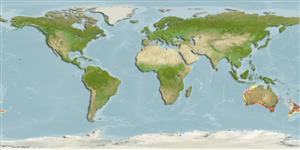Teleostei (teleosts) >
Perciformes/Uranoscopoidei (Sand dwellers) >
Uranoscopidae (Stargazers)
Etymology: Kathetostoma: Greek, kathetos, -on = lime + Greek, stoma = mouth (Ref. 45335); canaster: From the Latin for grizzled, referring to its distinctive color pattern (Ref. 42948).
More on authors: Gomon & Last.
Environment: milieu / climate zone / depth range / distribution range
Ecology
Marine; bathydemersal; depth range 30 - 700 m (Ref. 33839). Deep-water
Eastern Indian Ocean: southern Australia.
Size / Weight / Age
Maturity: Lm ? range ? - ? cm
Max length : 65.0 cm TL male/unsexed; (Ref. 33839)
Short description
Identification keys | Morphology | Morphometrics
Life cycle and mating behavior
Maturities | Reproduction | Spawnings | Egg(s) | Fecundities | Larvae
Gomon, M.F., C.J.M. Glover and R.H. Kuiter (eds.), 1994. The fishes of Australia's south coast. State Print, Adelaide. 992 p. (Ref. 33839)
IUCN Red List Status (Ref. 130435)
Threat to humans
Harmless
Human uses
Tools
Can't connect to MySQL database fbquizv2. Errorcode: Too many connections
